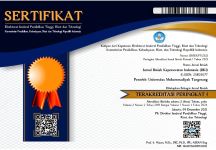The Effect of Giving Mint Decoction of Mint Leaves on the Reduction Of Nausea And Vomiting In First Trimester Pregnant Women at The Puskesmas Cipondoh Of Tangerang
Abstract
The first trimester of pregnancy is the formation that starts from the conception of the ovum with a sperm cell. Pregnancy is the process of conception that is complete with gestational age at 1 week to 12 weeks during pregnancy. In the first trimester of pregnancy a woman experiences complaints of nausea, vomiting. Pregnant women who experience nausea and vomiting can consume decoction of mint leaves because mint leaves contain essential oils which can help relieve nausea and vomiting. The purpose of this study was to determine the effect of mint leaf decoction on the reduction of nausea and vomiting in first trimester pregnant women at Puskesmas Cipondoh of Tangerang. This study used quantitative research with quasi-experimental research methods with one group pretest-posttest design. The sample in this study amounted to 10 respondents, selected through purposive sampling. Data retrieval was done using the Pregnancy Unique Quantification of Emesis And Nausea (PUQE) questionnaire to measure nausea and vomiting. Data analysis used the Wilcoxon statistical test with a confidence level of 95%. The results of this study found that there was an effect of giving decoction of mint leaves to a decrease in nausea and vomiting in first trimester pregnant women in Puskesmas Cipondoh Kota Tangerang with p value= 0.008 (p < 0.05). The conclusion of this study is that giving mint leaves boiled for three days can reduce nausea and vomiting in pregnant women. This research can be recommended to add the number of samples so that they can be made into two intervention groups and control groups so that they can be used as comparative materials. Researchers expect health workers to be able to implement therapy to reduce nausea and vomiting by using mint leaves.
Keywords: Mint leaves, Pregnancy, Nausea vomiting
Full Text:
AZIZAH_PDFReferences
Andriani, dkk. 2017. Pengaruh Aromaterapi Peppermint Terhadap Kejadian Mual Dan Muntah Pada Ibu Hamil Trimester 1 Di Puskesmas Mlati II Sleman Yogyakarta.
Anita, Aprina, dan Aryani, R. 2018. Perbedaan Mual dan Muntah Ibu Hamil Trimester I yang Diberikan Ekstrak Jahe dan Ekstrak Daun Mint. Jurnal Kesehatan 9(2): 253–261.
Banun, S. Istiqomah, T, dan Yani, D. P. 2017. Pengaruh efektifitas pemberian seduhan daun peppermint pada ibu hamil terhadap penurunan frekuensi emesis gravidarum. Jurnal Maternity and Neonatal, 1(2): 103–107.
Elshabrina. 2013. Dahsyatnya Daun Obat Sepanjang Masa. Yogyakarta: Cermelang Publishing.
Gusti, A.M., dkk. 2016. Asuhan Kebidanan Kehamilan Berbasis Kompetensi Edisi 3. Jakarta: EGC.
Ira, P. 2012. Sembilan puluh dua pengobatan mandiri di rumah anda a-z gangguan kesehatan umum, cara mencegah dan cara mengatasinya.Yogyakarta: Bangkit.
Irianti. 2015. Gambaran Karateristik Ibu Hamil Dengan Hiperemesis Gravidarum Tingkat 1.
Iskandar, I. 2017. Efeketifitas Daun Mint Terhadap Hiperemesis Gravidarum Di RumahSakit Daerah Haji Makassar. Jurnal Mitrasehat. Vol.7 No.2 2089-2551.
Patimah, O. P., & Sulaeman, S. 2019. Matahari Dan Kombinasi Terhadap Mual Dan Muntah Pada Ibu Hamil Trimester I Di Wilayah Kerja Puskesmas Cibeber Kabupaten Cianjur Jawa Barat Tahun 2018.Vol.1–11.
Tiran, D. 2008. Mual Muntah Kehamilan. Jakarta: EGC
DOI: http://dx.doi.org/10.31000/jiki.v2i2.2070
Article Metrics
Abstract - 1414 AZIZAH_PDF - 2482DOI (AZIZAH_PDF): http://dx.doi.org/10.31000/jiki.v2i2.2070.g1270
Refbacks
- There are currently no refbacks.
Copyright (c) 2019 Jurnal Ilmiah Keperawatan Indonesia (JIKI)
JIKI: Jurnal Ilmiah Keperawatan Indonesia a Creative Commons Attribution-ShareAlike 4.0 International License. © All rights reserved 2017.
View My Stats


